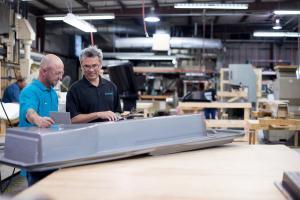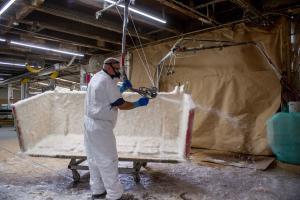At Arrowhead Plastic Engineering, we operate 2 separate facilities in east-central Indiana. One plant specializes in fiberglass composites and the other plant thermoforms plastic parts. We are often asked, “What’s the difference between the two.” That’s a great question with a complex answer.

Fiberglass is what is considered a thermoset composite, whereas Thermoformed Plastic is a thermoplastic. The biggest difference between the two is that thermosets can be used one time and that is it. Whereas thermoplastics can be melted and reused (ie. recycled). In thermoset composites such as fiberglass, a resin and catalyst (hardening agent) are mixed together and over time the molecules begin to crosslink and thus change on the molecular level. This is a process that can’t be undone or repeated utilizing the same materials. Thermoplastics however can be heated and made into a form and then chopped up, reheated and made into a different form….much like wax.
Thermosets such as fiberglass generally have a very high strength to weight ratio and are usually much more rigid at the same thickness than their thermoplastic counterparts. Although, advances are being made in the thermoplastics industry that allow for much stiffer thermoplastics and seem to blur the lines between thermosets and thermoplastics.
Arrowhead has large thermoforming machines (one of which can produce a part from a sheet of plastic that is 9′ x 9′) and even with machines this large, sometimes a customer will need a part that is too big for the machine. Or, a customer may have a part that is very tall. Extremely tall parts can cause thermoformers some challenges and sometimes an extremely thick sheet of material needs to be utilized in order end up with a part that is of the desired thickness after forming. Plastic sheet manufacturers are limited in how thick of a sheet they can produce so there are some limitations there.

Making a part from fiberglass eliminates this issues as part size in fiberglass isn’t really an issue. As long as we can fit the part out of the door, we can produce the part. Fiberglass parts allow for molded in ribbing, inserts, strengthening components, etc to be added to the part. Fiberglass parts can also be fixed if they are damaged (within reason). Thermoformed parts can’t usually be easily fixed if they have been damaged and bonding in ribbing, inserts, strengthening components can be done…but usually not as easily as can be accomplished with fiberglass.
Lastly, for the most part, thermoformed parts tend to cost less than fiberglass parts and less tooling is required to produce the same amount of parts compared to fiberglass.
So the bottom line is, which way to go (thermoformed plastic vs fiberglass molding) really depends on the project parameters as there are pros and cons to both.
Click the following links for a few examples of molded fiberglass and thermoformed plastic parts Arrowhead has produced. Interested in learning more about using fiberglass and/or thermoformed plastic parts in your project? Give us a ring or contact us to start the conversation. We’re happy to help!

